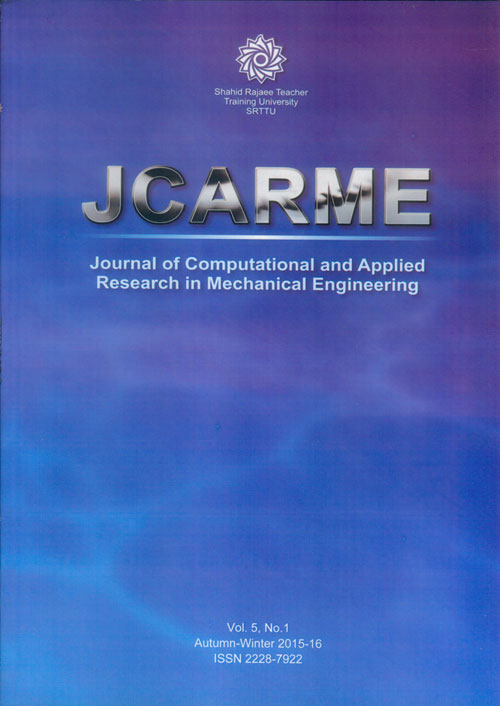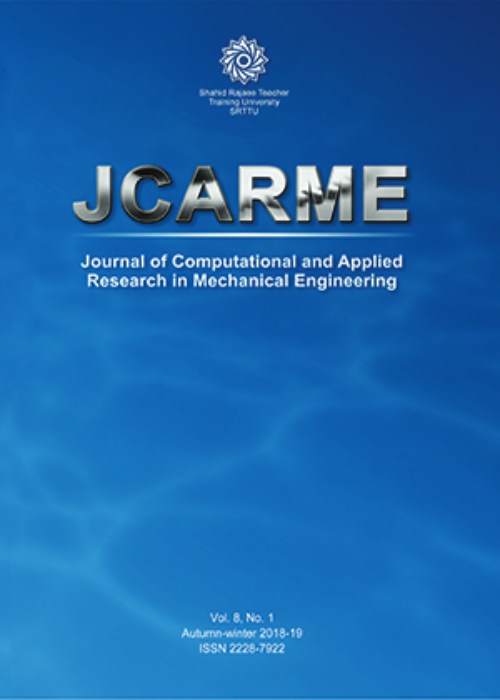فهرست مطالب

Journal of Computational and Applied Research in Mechanical Engineering
Volume:5 Issue: 1, Autumn 2015
- تاریخ انتشار: 1394/06/26
- تعداد عناوین: 7
-
-
Page 1Crack identification is a very important issue in mechanical systems, because it is a damage that if develops may cause catastrophic failure. In the first part of this research, modal analysis of a multi-cracked variable cross-section beam is done using finite element method. Then, the obtained results are validated usingthe results of experimental modal analysis tests. In the next part, a novel procedure is considered to identify the locations and depths of cracks in the multi-cracked variable cross-section beam using natural frequency variations of the beam based on artificial neural network and particle swarm optimization algorithm. In the proposed crack identification algorithm, four distinct neural networks are employed for the identification of locations and depths of both cracks. Back error propagation and particle swarm optimization algorithms are used to train the networks. Finally, the results of these two methods are evaluated.Keywords: Modal analysis, Multiple crack, identification, Variable cross section, beam, Artificial neural network
-
Page 13Nowadays, due to the increasing power of diesel engines, especially heavy duty diesel engines, and increasing gas pressure inside the combustion chamber, the forces acting on the engine bearings have dramatically raised. On the other hand, becaus eof the competition in the market, it is necessary to increase the engine bearing life and reduce its failure as much as possible. The engine bearings analysis is a vital issue in engine design process as well as other related engineering tasks such as engine power upgrading, reverse designing, and bearing failure analysis. So, many attempts have been made to simulate accurate engine bearings. In this paper, results of a thermoelasto- hydrodynamic (TEHD) analysis of a connecting rod big end (BE) bearing of a heavy duty diesel engine are presented. Here, the oil film viscosity is considered a function of oil''s local temperature and pressure. Effects of flexibility of bearing shell and connecting rod structure are also considered. Therefore, the computed oil film pressure and temperature distributions are relatively precise. In the proposed analytical procedure, at first, elasto-hydrodynamic (EHD) analysis is carried out and the averaged fluid velocity in the bearing is obtained. Then, the averaged heat transfer coefficient between oil film and crank pin is calculated, which is used as an input in TEHD analysis. Results of EHD and TEHD analyses are compared with each other and the main characteristic parameters in bearing design are reported and interpreted.Keywords: Thermo, elastohydrodynamic (TEHD) analysis, EHD, BE bearing, Diesel engine
-
Page 25In this paper, the nonlinear free vibrations of thin symmetric and nonsymmetric cross-ply composite plates subjected to biaxial initial stresses are investigated. Because of their excellent properties such as specific strength and specific stiffness, composite plates have wide applications in aerospace and mechanical structures. Based on Von-Karman''s strain-displacement relations and using Galerkin method, the nonlinear differential equation of free vibrations of initially stressed composite plate is obtained. This nonlinear equation is solved using two different analytical perturbation methods, namely method of multiple scales (MTS) and homotopy perturbation method (HPM), to analyze the nonlinear vibrations of initially stressed cross-ply composite plates. Effects of tensile and compressive biaxial initial stresses, initial vibration amplitude, thickness, and aspect ratios of the composite plates on the frequency behavior are investigated. The validity of the results is confirmed by making a comparison with those reported in the literature. According to the results, both analytical solutions show increasing trends for natural frequency parameters by increasing normal initial stresses. Regardless of the value of initial biaxial stresses, for both symmetric and non-symmetric plates, the results of MTS and HPM are in close agreement for the smallest initial amplitude. However, for compressive initial stresses, by increasing initial amplitude ratios, the discrepancies between the results of HPM and MTS increase for symmetric and non-symmetric plates. Although HPM includes less computational effort (smaller length of formulation) than MTS, the linear-to-nonlinear frequency ratios obtained using MTS method become closer to those obtained by HPM as initial vibration amplitude is decreased and initial stress is increased.Keywords: Nonlinear vibrations, Biaxial initial stress, Homotopy perturbation, method, Multiple scales, perturbation method
-
Page 37One of the new research fields in plasticity is related to choosing a proper non-associated flow rule (NAFR), instead of the associated one (AFR), to predict the experimental results more accurately. The idea of the current research is derived from combining von Mises and Tresca criteria in the places of yield and plastic potential surfaces in rate-independent plasticity. This idea is implemented using backward Euler method in non-linear finite element simulation. The results are compared with the experimental data for an internally pressurized thick-walled cylinder and it is demonstrates that, using the proposed NAFR in rate-independent plasticity, the experimental results could be predicted more accurately. Finally, it can be said that the current research confirms the results of the previous works on rate-dependent plasticity (viscoplasticity) in steady state conditions.Keywords: Non, associated flow rule, Backward Euler method, Thick walled cylinder, Consistent algorithm, Lode parameter
-
Page 51Recently, a large amount of studies have been related to nonlinear systems with multi-degrees of freedom as well as continuous systems. The purpose of this paper is to optimize passive vibration absorbers in linear and nonlinear states for an Euler-Bernoulli beam with a nonlinear vibratory behavior under concentrated moving load. The goal parameter in the optimization is maximum deflection of the beam. The large deformation for beam modeling is considered, i.e. the relation between strains and deflections is nonlinear. The force magnitude and beam length are two effective factors for the beam deflection. Vibration absorber with linear damping and linear or nonlinear stiffness is also considered in this manuscript. The results show that, for normal forces and short beams, linear and nonlinear models have similar behaviors, while surveying nonlinear behavior is necessary by increasing the force and length of the beam, i.e. large deflections. Moreover, the difference between linear and nonlinear beam models for regular force magnitudes and beam lengths is negligible. For higher loads and longer beams, beam model nonlinearity can be important. Results demonstrate that,in the presented numerical values (train bridge application) for cubic nonlinear vibration absorber, there are two optimal locations for vibration absorber installation: one inclined from the middle of the beam to the direction of moving loads and the second which is more interestingly inclined from the middle of the beam to moving loads in the opposite direction. Moreover, depending on the model''s numerical parameters, for short beams, linear vibration absorber is more effective, while for long beams, cubic nonlinear beam behaves better than the linear one.Keywords: Nonlinear beam model, Moving load, Nonlinear vibration, absorber
-
Page 61The purpose of this paper is to studying nonlinear k-ε turbulence models and its advantages in internal combustion engines, since the standard k-ε model is incapable of representing the anisotropy of turbulence intensities and fails to express the Reynolds stresses adequately in rotating flows. Therefore, this model is not only incapable of expressing the anisotropy of turbulence in an engine cylinder, but also is unable to provide good performance when computing the swirling and tumbling flows is important in engine cylinders. Thus, in this paper, the results of nonlinear k-ε model are compared with those of the linear one. Results of diesel engine simulation with linear and nonlinear k-ε models in comparison show that turbulence intensity in the nonlinear model simulation is higher than that of the linear model; also, nonlinear k-ε models predict the second peak value because of the bowl shape in expansion stroke for turbulence intensity. Gas injection results show that nonlinear turbulence models predict spray penetration accurately because of correctly turbulence intensities predicting. Also, the results demonstrate that, for high pressure gas injection, turbulence intensity is high and predicted accurately using nonlinear models. Then, its spray penetration length is predicted accurately in comparison to experimental data’s. Although CPU time spending in the nonlinear model is more than that of the linear one, the non-linear stress model is found to increase computation time by 19%.Keywords: Engine, Flow, Simulation, Nonlinear k, ε, Turbulence model
-
Page 71In this paper, a rectangular sandwich plate with a constrained layer and an electrorheological (ER) fluid core is investigated. The rectangular plate is covered an ER fluid core and a constraining layer to improve the stability of the system. The two outer layers of the sandwich structure are elastic. The viscoelastic materials express the middle layer behavior under electric field and small strain. Rheological property of an ER material, such as viscosity, plasticity, and elasticity, may be changed when applying an electric field. The ER core is found to have a significant effect on the stability of the sandwich plate. In this paper, based on the displacement field of each layer, the kinetic energy and strain energy are separately obtained for each layer. Transverse displacement of the second layer changes linearly between the transverse displacement of the first and third layers. The loss energy of the second layer consisting of the ER fluid is also calculated and, with the replacement of total kinetic energy, total strain energy, and energy dissipation in the Lagrange''s equation, the structural motion equation is obtained. Natural frequencies and loss factor for the electric fields as well as the ratio of different thicknesses calculated are by Navier analytical method. As the applied electric field increases, the natural frequency of the sandwich plate increases and the modal loss factor decreases. With increasing the thickness of the ER layer, the natural frequencies of the sandwich plate are decreased. Thickness of the constrained layer also affects the stability of the sandwich plate.Keywords: Free vibrations, Sandwich plate, Electrorheological fluid, Natural frequencies, Loss factor


